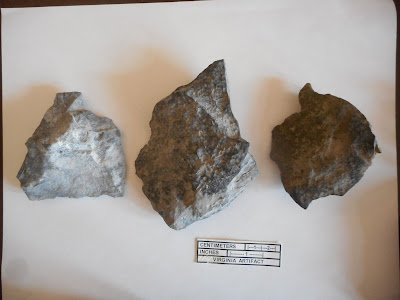Limestone mammoth or mastodon figure
Jeremy Lowcock find, Vermont
"I found these in the Northeast Kingdom in Vermont. I was hunting for serpentine to make some hand made cabochon and I started noticing that some looked like faces and animals. It blew my mind what I was finding and for a while I thought it was just my imagination but I have found some crazy stones. Do you have any idea what this is all about? I have found what looks like an elephant or mastodon and I gotta say I am really dumbfounded. Any insight would be appreciated, this is keeping me up nights." - Jeremy
The Vermont location of Jeremy's surface survey finds suggests the people who made or collected this art were living along the retreating Laurentide ice sheet at the end of the last glacial maximum after around 13,500 years ago and presumably before the ca. 10,000 years ago extinction of the mammoths or mastodons depicted in the stone figures.
Mammoth likeness identified by Jeremy Lowcock
Standing mammoth likeness, side hole serves as 'eye,' hole in top of head may have had some purpose.
Vermont simple face 1
Vermont simple face 2
Vermont simple face 3
This gemstone serpentinite rock has a natural pattern which may have been noticed as a human face likeness in the Stone Age and collected with the other iconic stones found in the area
Detail of natural human face-like pattern which may have been noticed in prehistory, prompting collection and transport of the stone. Its high level of polish may indicate it was curated for some time.
Sculpture of 'Crouching feline, ready to pounce from above'
The highest visual point on the stone is the peak of the feline's arched back. There may be a depiction of the cat's left front paw. There also appears to be a nicely carved 'tail.'
'Crouching feline figure on a rock' faces viewers directly. The feline looks ready to pounce from above. This is a single stone where the crack delineates the animal from the rock it is 'standing on'. (Click photos to expand and toggle between marked and unmarked photos.)
Close up of the animal's face detail. The bifurcated chin helps tell us this is a feline.
Crude tools and a flake core identified by Jeremy Lowcock, Northeast Kingdom, Vermont, in the portable rock art context. The relationship of these kinds of tools to the art is suspected but must be confirmed by future archaeology work at multiple sites.
Willoughby Notch and Mt. Pisgah, Vermont
It seems the earliest Americans may have been using simple flake and bend-break tools to serve their needs. Similar simple points have been identified at the deepest levels of the Topper Site, Allendale County, South Carolina, with a 50,000 years BP date proposed.





















































